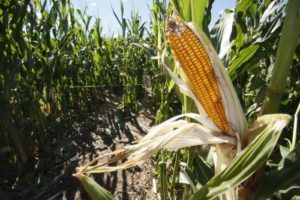Genes and Things – On Growing Indian Corn
by Gary Mount
One of the things that I like best about farming is that just when I am getting complacent – feeling that I know all about farming- some new knowledge or new crop comes along that puts me in my place. I become challenged, intrigued and determined to learn all that I can.
 Each year I seem to find another new and interesting crop to grow but this year’s most interesting crop is one I have been growing for many years-Indian Corn. That’s the old-time name for it, coming from the colored varieties grown by western Native Americans and ground into flour. In fact Pam and I were once recipients of blue cornbread baked by Fred and Donald Fox of Princeton from flour they ground themselves on a bicycle-powered grinder.
Each year I seem to find another new and interesting crop to grow but this year’s most interesting crop is one I have been growing for many years-Indian Corn. That’s the old-time name for it, coming from the colored varieties grown by western Native Americans and ground into flour. In fact Pam and I were once recipients of blue cornbread baked by Fred and Donald Fox of Princeton from flour they ground themselves on a bicycle-powered grinder.
Today’s politically correct name is Ornamental Corn, but somehow Indian corn seems better. A friend who described himself as the Indian Corn Champ of Pennsylvania approached me this year. He has been breeding Indian corn since he was ten years old and actually put himself through college by growing Indian corn! This might seem far-fetched except that some 15,000 ears of Indian corn grow on one acre. Figure 25 to 50 cents an ear- you get the picture.
It has become difficult for my friend to continue his Indian corn work on his family farm in Pennsylvania. Not only does he now live near me here in New Jersey, but also he works about eight days a week. He and I formed a “partnership.” All around the edge of the Terhune Orchards pumpkin patch this year are a total of eight different varieties of his Indian corn – giant, miniature, popcorn, red, multicolored, green husk, purple husk. All summer he has been checking the corn. Each type is planted in four rows and is by itself so that the wind can blow pollen from one plant to another- thus pollinating each kernel on each ear, but not onto another type of Indian Corn. That would result in a genetic mix-up and unpredictable looking corn.
It turns out that genes are everything in corn growing and especially Indian corn growing. My friend has been checking for genetic traits such as disease and insect resistance, color of the husk, height, size of the ear and relative maturity date. In September, he will harvest some of each and check for color of the kernel and shiny or dull appearance. Amazingly, regular yellow field corn and red Indian corn only differ by 1 or 2 genes. Then he will make the final choice of what seed to save to plant again next year. Hopefully this year’s seed will yield a better result than last year’s, next year’s seed will be better than this year’s, and so on.
